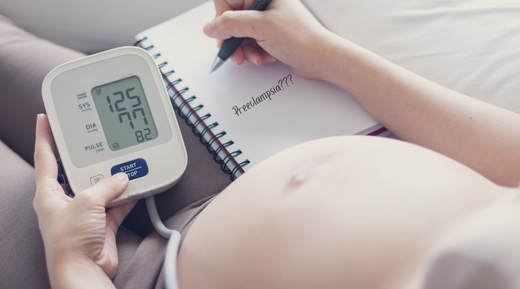
Understanding Preeclampsia: A Personal Journey
Share
Pregnancy is often described as a magical time, filled with hope, excitement, and dreams for the future. But for some, it can take an unexpected and challenging turn. I know this because I’ve been there.
My journey through pregnancy was profoundly shaped by a condition called preeclampsia, a life-changing experience that has fueled my passion for raising awareness and supporting others.
If you're reading this, it’s likely because you want to learn more, and that is a powerful first step.
Together, let’s explore what preeclampsia is, how to recognize it, and how we can work towards healthier pregnancies for every family.
Before we dive in, I want to be clear: I am not a medical professional. What I share here is based on my personal experience and years of research. Always consult with a qualified healthcare provider for medical advice and guidance.
What Is Preeclampsia?
Preeclampsia is a condition that develops during pregnancy, usually after the 20th week. It’s characterized by high blood pressure and potential damage to organs, often the liver or kidneys.
In my case, it came as a shock.
Like many, I had no idea how quickly things could escalate, especially if you tried to do everything "by the book"!
What made it even more startling was that I had always had low blood pressure prior to pregnancy. I never imagined that a condition associated with high blood pressure could affect me. But preeclampsia doesn’t discriminate; it’s a condition that can arise unexpectedly and with devastating consequences if not detected early.
Awareness, vigilance, and care are key.
Who Is at Risk?
Preeclampsia doesn’t discriminate; it can affect any expectant mother. However, certain factors may increase the risk:
- First pregnancies: Preeclampsia is more common in first-time moms.
- Family history: If a close relative experienced it, your risk may be higher.
- Underlying health conditions: High blood pressure, diabetes, or kidney problems can contribute.
- Multiple pregnancies: Carrying twins or more increases the likelihood.
- Age considerations: Women under 18 or over 35 face greater risks.
When I learned about these risk factors, it gave me clarity. Understanding them empowers you to have open conversations with your healthcare provider and to advocate for yourself.
What to Watch For
Preeclampsia symptoms can sometimes be subtle, but paying attention can save lives. Watch for:
- Persistent high blood pressure
- Swelling in the hands, face, or feet (beyond the usual pregnancy swelling)
- Severe, unrelenting headaches
- Vision changes, like blurriness or seeing spots
- Pain in the upper abdomen, under the ribs
- Nausea or vomiting late in pregnancy
- Sudden, unexplained weight gain
For me, the symptoms felt overwhelming and confusing. But I learned that it’s always better to ask your doctor or midwife if something feels off. Trust your instincts; they are there to protect you.
Finding Hope and Prevention
Though there’s no guaranteed way to prevent preeclampsia, small steps can make a difference:
- Stay informed with regular prenatal checkups.
- Prioritize your well-being with nutritious meals, gentle activity, and stress management.
- Follow medical advice, including treatments like low-dose aspirin if recommended.
For me, a turning point in my journey came after my first heartbreaking loss.
I began researching natural ways to support my body during pregnancy, and that’s when I discovered the potential benefits of magnesium.
This incredible mineral not only supports muscle relaxation and reduces stress but is also known to help manage blood pressure, a key factor in preeclampsia.
Magnesium Baths: My Pregnancy Ritual
With my subsequent pregnancies, I started doing magnesium baths almost every night. These baths became my sanctuary, a calming ritual where I could connect with my growing baby while giving my body the care it deserved.
Beyond relaxation, I believe they played a part in helping me maintain healthier pregnancies, supporting both my physical and emotional well-being.
But the journey wasn’t without its challenges. After losing my first baby boy, every subsequent pregnancy came with an undercurrent of fear.
I remember holding my breath during ultrasounds, waiting anxiously to hear that heartbeat.
On days when I didn’t feel my baby kick as much, panic would creep in, and I’d find myself hyper-focused on every little sensation.
When I experienced intense anxiety, I would listen to pregnancy meditation during my soaks to help calm and soothe myself.
The trauma of that initial loss made it difficult to trust my body again, but my magnesium soaks became a small, grounding ritual that helped me navigate the anxiety and reconnect with hope.
What made these baths even more meaningful was their symbolism. They were more than just a way to absorb magnesium; they represented hope, healing, and my commitment to a different outcome.
Each soak was a moment to reflect, recharge, and reclaim my sense of empowerment.
After Preeclampsia
Preeclampsia doesn’t always end with delivery; like in my case, the journey continued well beyond that.
After I lost my baby boy and required surgery for delivery, I was rushed back to the hospital just days later. The challenges I faced during this time made me realize how crucial long-term health truly is.
Women who’ve experienced preeclampsia are at a greater risk of heart problems later in life, making it essential to remain vigilant and proactive in managing our health moving forward.
A Personal Message of Encouragement
My journey with preeclampsia was one of the hardest things I’ve faced. Losing my baby boy, Danté, due to preeclampsia changed me in ways I never expected.
It shook me, but it also inspired me to explore natural ways to restore balance and align mind, body, and soul.
Today, I am grateful to share that my story didn’t end there.
After that heartbreaking loss, I went on to have two healthy, beautiful children who light up my life.
They are my greatest blessings and a reminder that hope, and healing is possible.
If you’re walking this path now, know that you’re not alone.
You are stronger than you realize, and there is a community of people who understand what you are going through and really care.
This is why I share my story, to raise awareness and help others feel less isolated.
Together, we can spread hope, compassion, and knowledge so that every pregnancy has a chance to be safe and celebrated.

